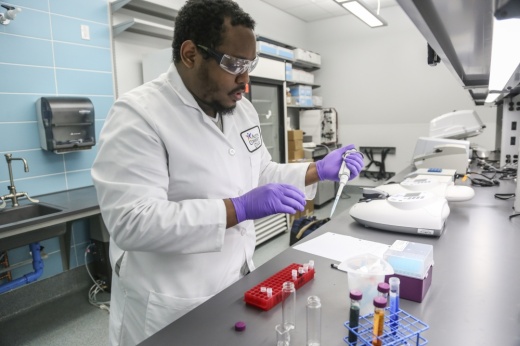To make way for this growth to continue, Austin City Council created a research and life sciences subdistrict within the North Burnet/Gateway development regulating plan Nov. 9.
“A lot of the innovation is going to start coming, and I think that Austin ... is really primed well for that,” said Jason Scharf, an investor in the life science space and founder of Austin Next.
Two-minute impact
The biological science and health care industries, referred to as life sciences, have seen rapid growth in the Austin area since 2019. With hundreds of companies already established and several lab space projects in the pipeline, Austin leaders see incoming startups as the city’s next frontier.
“The investment in health sciences benefits the entire community,” said Bryce Bencivengo, director of public relations and media for the Austin Chamber of Commerce. “We have opportunities to capitalize on companies that are here to create unique partnerships, to improve the health and well-being of our Central Austin region.”
State of the industry
As of July, Austin’s life sciences industry includes:
- Over 260 companies
- Over 18,000 employees
- Nearly 74% employment growth since 2019
- 1.6M square feet of lab space
In a nutshell
Life sciences is an umbrella term used to describe many biological sciences, from the study of lab specimens to the treatment of patients, according to the report. Some products of the industry include medical devices, such as cochlear implants, and the development of cures for different cancers.
At the local scale, life sciences and health services make up about 11.6% of the local economy, according to data from the U.S. Bureau of Labor Statistics. Bencivengo said the industry is one more opportunity for Austin to continue diversifying its economy to withstand hardships.
Alongside southern Austin, the North and Northwest Austin markets represent a hotspot for this growth, Bencivengo said.
How we got here
There are several indicators that point to whether an area is a good option to pursue life sciences, said Matt Schwab, managing director of Karlin Real Estate. Among those, Austin stands out in the relatively young age of the average working individual at 35.8 as well as its large supply of educational institutions.
The abundance of local higher education facilities paves the way for a reliable workforce for life science companies, Schwab said.
Local schools
Between the University of Texas, Austin Community College and other local colleges, there are:
- About 8,800 science, technology, engineering and math graduates annually
- About 4,700 health care graduates annually
- Clinical laboratory technologists and technicians: $56,900
- Bioengineers and biomedical engineers: $81,980
- Registered nurses: $86,720
- Health care diagnosis or treating practitioners: $113,530
The bigger picture
While Austin has potential for a successful industry, available lab space remains an issue, said Nancy Lyon, the director of Austin Community College’s Bioscience Incubator. The facility offers the only rentable lab space in Austin, Lyon said. The incubator provides communal equipment and spaces, but only to startups that need the specific equipment.
“It’s such a finite market. We really only cover this little niche,” Lyon said.
That is not to say infrastructure is not on the way, however, Schwab said. Karlin Real Estate officials announced in September the allocation of 10,000 square feet of lab space to UT for startups, representing one-tenth of its 100,000-square-foot lab and office space building at Parmer Austin. Schwab said the company also has a lab space with hundreds of thousands of square feet opening in early 2024 in the former 3M building in Austin, now called Highpoint at 2222.
Upcoming Karlin lab facilities include:
- Newly delivered 100,000-square-foot lab building, with 10,000 square feet for UT’s life sciences startup launcher
- 190,000-square-foot lab and office building ready to develop
- A lab project with hundreds of thousands of square feet, called Highpoint at 2222
Looking ahead
Compared to major research hubs across the country, from the top-performing Research Triangle Park in North Carolina to Texas’ own largest industry in Houston, Austin has a small life science industry, by all measures. Regardless, the exponential growth of Austin’s industry in three years proves that despite its size, life science opportunities are high in demand, Schwab said.
“There’s very high growth, but it’s in its [beginning] stages of growing, which is why we’re so excited about it,” Schwab said. “We see no reason why there won’t be more and bigger companies coming our way if the infrastructure and real estate projects are there for these tenants to come.”
Needs for industry growth
For the industry to continue to grow, the report from Austin Next and Austin Medtech Connect said the following must be prioritized:
- More available lab space
- Further investment into life sciences industry
- Continued supply of skilled workforce






